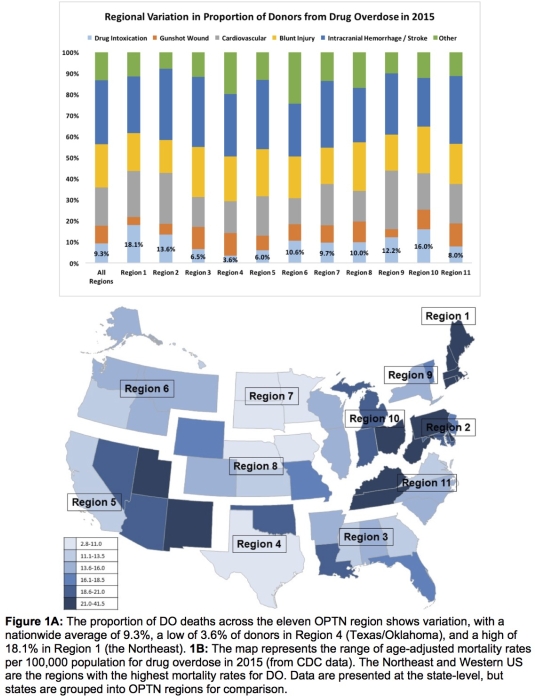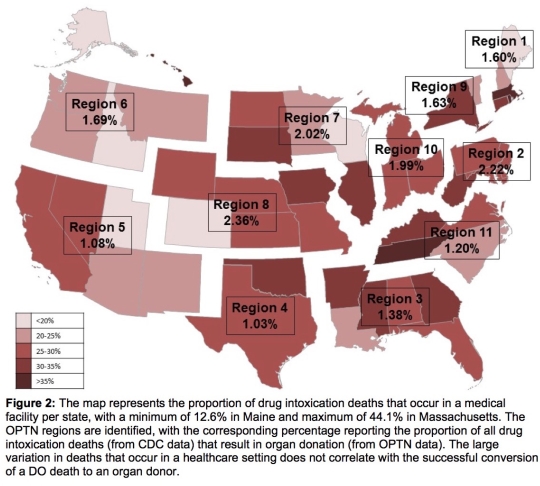Despite the Growing Impact of the American Opioid Epidemic on Organ Donation, a Small Percentage of Drug Intoxication Deaths Result in Organ Donation
1Department of Surgery, University of Alabama at Birmingham, Birmingham, AL
2Alabama Organ Center, Birmingham, AL.
Meeting: 2018 American Transplant Congress
Abstract number: 596
Keywords: Donation, Procurement, Resource utilization
Session Information
Session Time: 8:30am-10:00am
 Presentation Time: 9:30am-9:45am
Presentation Time: 9:30am-9:45am
Location: Room Hall B
Purpose: This study seeks to understand the regional variation in donations after drug overdose (DO) and quantify the proportion of DO deaths that go on to become organ donors in the US.
Materials & Methods: We analyzed data from the Organ Procurement and Transplantation Network (OPTN) that included deceased donors with DO as mechanism of death who donated between January 1, 2000 and December 31, 2016. National mortality data was obtained from the National Center for Health Statistics from the Centers for Disease Control and Prevention (CDC) online mortality database.
Results & Discussion: Organ donation after DO is increasing at an alarming rate; among those donors with a reported cause of death, DO accounted for 1.1% of donors in 2000 compared to 12.7% in 2016. State age-adjusted mortality rates for DO in 2015 correlate with OPTN regions with the highest percentage of donors from DO (Figures 1a & 1b). However, high mortality rates do not correlate with the percentage of all DO deaths that become organ donors (Figure 2). Despite 28.2% of drug overdose deaths occurring in health care facilities in the US in 2015, only 1.62% become organ donors. The region with the highest percentage of deaths that become donors (2.36% Region 8 in the Midwestern US) has one of the lowest mortality rates; furthermore Region 8 had over two-fold the DO donation rate as Region 4 (1.03% in Texas/Oklahoma).
Conclusion: OPTN regions with the highest mortality from drug overdose have the largest proportion of donors, but mortality rate does not correlate with the percentage of drug intoxication deaths that eventually become donors. More research is needed to understand the observed regional variation and barriers to maximizing donation after death from DO.
CITATION INFORMATION: Hickman L., Killian J., Windham S. Despite the Growing Impact of the American Opioid Epidemic on Organ Donation, a Small Percentage of Drug Intoxication Deaths Result in Organ Donation Am J Transplant. 2017;17 (suppl 3).
To cite this abstract in AMA style:
Hickman L, Killian J, Windham S. Despite the Growing Impact of the American Opioid Epidemic on Organ Donation, a Small Percentage of Drug Intoxication Deaths Result in Organ Donation [abstract]. https://atcmeetingabstracts.com/abstract/despite-the-growing-impact-of-the-american-opioid-epidemic-on-organ-donation-a-small-percentage-of-drug-intoxication-deaths-result-in-organ-donation/. Accessed December 24, 2025.« Back to 2018 American Transplant Congress


